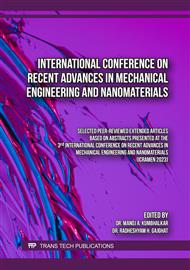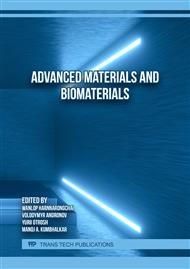[1]
FS. Dutta, N.K. Kim, R. Das, D. Bhattacharyya, Effects of sample orientation on the fire reaction properties of natural fibre composites, Composites Part B: Engineering. 157(2019) 195-206.
DOI: 10.1016/j.compositesb.2018.08.118
Google Scholar
[2]
M. Sood, G. Dwivedi, Effect of fibre treatment on flexural properties of natural fibre reinforced composites: A review, Egyptian Journal of Petroleum. 27(2018) 775-783.
DOI: 10.1016/j.ejpe.2017.11.005
Google Scholar
[3]
S.V. Joshi, L.T. Drzal, A.K. Mohanty, and S. Arora, Are natural fibre composites environmentally superior to glass fibre reinforced composites, Composites Part A: Applied Science and Manufacturing. 35 (2004) 371-376.
DOI: 10.1016/j.compositesa.2003.09.016
Google Scholar
[4]
S.A.S. Goulart, T.A. Oliveira, A. Teixeira, P.C. Mileo and D.R. Mulinari, Mechanical Behaviour of Polypropylene Reinforced Palm Fibres Composites, Procedia Engineering. 10 (2011) 2034.
DOI: 10.1016/j.proeng.2011.04.337
Google Scholar
[5]
G. Ajith, M.S. Kumar, and A. Elayaperumal, Experimental investigations on mechanical properties of jute fibre reinforced composites with polyester and epoxy resin matrices, Procedia Engineering. 97 (2014) 2052-2063.
DOI: 10.1016/j.proeng.2014.12.448
Google Scholar
[6]
D.H. Mueller and A. Krobjilowski, New discovery in the properties of composites reinforced with natural fibres, Journal of Industrial Textiles. 33 (2003) 111-130.
DOI: 10.1177/152808303039248
Google Scholar
[7]
A.S. Singha, V.K. Thakur, Fabrication, and characterization of H. Sabdariffa fibre-reinforced green polymer composites, Polymer-Plastics Technology and Engineering. 48 (2009) 482-487.
DOI: 10.1080/03602550902725498
Google Scholar
[8]
Y. Tong, D.H. Isaac, Impact and fatigue behaviour of hemp fibre composites, Composites Science and Technology. 67 (2007) 3300-3307.
DOI: 10.1016/j.compscitech.2007.03.039
Google Scholar
[9]
W. Paul, J. Ivens, I. Verpoest, Natural fibres: can they replace glass in fibre reinforced plastics, Composites science and Technology. 63(2003) 1259-1264.
DOI: 10.1016/s0266-3538(03)00096-4
Google Scholar
[10]
F.P. La Mantia, M. Morreale, Green composites: A brief review, Composites Part A: Applied Science and Manufacturing. 42 (2011), 579-588.
DOI: 10.1016/j.compositesa.2011.01.017
Google Scholar
[11]
J. Summerscales, N.P.J. Dissanayake, A.S. Virk and W. Hall, A review of bast fibres and their composites. Part 1–fibres as reinforcements, Composites Part A: Applied Science and Manufacturing. 41(10) (2010)1329-1335.
DOI: 10.1016/j.compositesa.2010.06.001
Google Scholar
[12]
M.R. Sanjay, G.R. Arpitha, B. Yogesha, Study on Mechanical Properties of Natural - Glass Fibre Reinforced Polymer Hybrid Composites: A Review, Materials Today: Proceedings. 2(4-5) (2015) 2959-2967.
DOI: 10.1016/j.matpr.2015.07.264
Google Scholar
[13]
P. Weaver, M. Dicker, P. Duckworth, A. Baker, G. Francois, M. Hazzard, Green composites: A review of material attributes and complementary applications, Composites Part A: Applied Science and Manufacturing. 56 (2014) 280-289.
DOI: 10.1016/j.compositesa.2013.10.014
Google Scholar
[14]
K. Begum, M. Islam, Natural fibre as a substitute to synthetic fibre in polymer composites: a review, Research Journal of Engineering Science. 2278 (2013) 9472.
Google Scholar
[15]
T. Mukherjee, N. Kao, PLA based biopolymer reinforced with natural fibre: a review, Journal of Polymers and the Environment. 19(3) (2011) 714.
DOI: 10.1007/s10924-011-0320-6
Google Scholar
[16]
S. Tara, H.N.J Reddy, Application of sisal, bamboo, coir and jute natural composites in structural up gradation, International Journal of Innovation Management and Technology. 2(3) (2011) 186.
Google Scholar
[17]
A.K. Rana, A. Mandal, B.C. Mitra, R. Jacobson, Short jute fibre‐reinforced polypropylene composites: Effect of compatibilizer, Journal of Applied Polymer Science. 69(2)(1998)329-338.
DOI: 10.1002/(sici)1097-4628(19980711)69:2<329::aid-app14>3.0.co;2-r
Google Scholar
[18]
M. Ramesh, K. Palani Kumar, K.H. Reddy, Mechanical property evaluation of sisal–jute–glass fibre reinforced polyester composites, Composites Part B: Engineering. 48 (2013) 1-9.
DOI: 10.1016/j.compositesb.2012.12.004
Google Scholar
[19]
H. Ku, H. Wang, N. Pattara chaiya Koop and M. Trada, A review on the tensile properties of natural fibre reinforced polymer composites, Composites Part B: Engineering. 42 (4) (2011) 856-873.
DOI: 10.1016/j.compositesb.2011.01.010
Google Scholar
[20]
B.C. Mitra, R.K. Basak, and M. Sarkar, Studies on jute‐reinforced composites, its limitations, and some solutions through chemical modifications of fibres, Journal of Applied Polymer Science. 67(6) (1998) 1093-1100.
DOI: 10.1002/(sici)1097-4628(19980207)67:6<1093::aid-app17>3.0.co;2-1
Google Scholar
[21]
S. Banik, M.K. Basak, D. Paul, P. Nayak, D. Sardar, S.C. Sil, B.C. Sanpui, A. Ghosh, Ribbon retting of jute—a prospective and eco-friendly method for improvement of fibre quality, Industrial Crops and Products. 17 (3) (2003) 83-190.
DOI: 10.1016/s0926-6690(02)00097-3
Google Scholar
[22]
L. Mathew, K.U. Joseph, R. Joseph, Isora fibres and their composites with natural rubber, Progress in Rubber Plastics and Recycling Technology. 20(2004) 337-349.
DOI: 10.1177/147776060402000404
Google Scholar
[23]
Z. Ahmed, A. Firoza, Jute retting: an overview, Online J Biol Sci. 1 (2001) 685-688.
Google Scholar
[24]
J. Butt, H. Mebrahtu, H. Hassan Shirvani, Strength analysis of aluminium foil parts made by composite metal foil manufacturing, Progress in Additive Manufacturing. 1 (2016) 93–103.
DOI: 10.1007/s40964-016-0008-5
Google Scholar
[25]
P. Krishnasamy, G. Rajamurugan, M. Thirumurugan, Dynamic mechanical characteristics of jute fiber and 304 wire mesh reinforced epoxy composite, Journal of Industrial Textiles. 51(2021) 540–558.
DOI: 10.1177/1528083719883057
Google Scholar
[26]
M. Arulmurugan, K. Prabu, G. Rajamurugan, A.S. Selvakumar, Impact of BaSO4 filler on woven Aloe Vera/Hemp hybrid composite: Dynamic mechanical analysis, Materials Research Express 6 (2019)1-32.
DOI: 10.1088/2053-1591/aafb88
Google Scholar
[27]
D. Jain, A. Kothari, Hair fiber reinforced concrete. Research journal of recent sciences, 1, (2012) 128-133.
Google Scholar
[28]
M. V. R. Velasco, T.C.D.S. Dias, A.Z.D. Freitas Júnior, C.A.S.D.O. Pinto, T.M. Baby A.R. Kaneko, Aparecida Sales de Oliveira Pinto Claudinéia, Mary Kaneko Telma, Baby André Rolim, Hair fiber characteristics and methods to evaluate hair physical and mechanical properties, Brazilian Journal of Pharmaceutical Sciences 45(2009)153-162.
DOI: 10.1590/s1984-82502009000100019
Google Scholar
[29]
L.J. Wolfram, Human hair: a unique physicochemical composite, Journal of the American Academy of Dermatology, Vol. 48 (2003), pp.106-114.
Google Scholar
[30]
M. Khan and M. Ali, Effectiveness of hair and wave polypropylene fibres for concrete roads, Construction and Building Materials Vol. 166 (2018), pp.581-591.
DOI: 10.1016/j.conbuildmat.2018.01.167
Google Scholar
[31]
M.K. Sridhar, G. Basavarajjappa, S.S. Kasturi, N. Balasubramanian, Thermal stability of jute fibres, Indian Journal of Fibre and Textile Research Vol.7(1982), pp.87-91.
Google Scholar
[32]
P.J. Roe, M.P. Ansell, Jute-reinforced polyester composites, Journal of Materials Science 20(1985) 4015-4020.
DOI: 10.1007/bf00552393
Google Scholar
[33]
C. Elanchezhian, B. Vijaya Ramnath, M.U. Sughan, K. Suseetharan, V. Varun Kumar, R. Vezhavendan, R. Kaosik R., Evaluation of mechanical properties of human hair- bombyxmori silk fibre reinforced epoxy-based bio composite ARPN Journal of Engineering and Applied Sciences. 10 (2015)13.
Google Scholar
[34]
R.K. Misra, N.V. Rachchh, Mechanical Performance of Coir Fiber Reinforced Polyester Composite, International Journal of Advanced Materials Science.1(2011)1.
Google Scholar
[35]
S.N. Monteiro, F.P.D. Lopes, A.P. Barbosa, A.B. Bevitori, I.L.A. Da Silva, and L.L. Da Costa, Natural lignocellulosic fibres as engineering materials—an overview, Metallurgical and Materials Transactions A. 42(2011) 2963.
DOI: 10.1007/s11661-011-0789-6
Google Scholar
[36]
I.P. Seshadri, and B. Bhushan, Effect of ethnicity and treatments on in situ tensile response and morphological changes of human hair characterized by atomic force microscopy, Acta Materialia. 56 (2008) 3585-3597.
DOI: 10.1016/j.actamat.2008.03.039
Google Scholar
[37]
C. LaTorre, B. Bhushan, Nanotribological characterization of human hair and skin using atomic force microscopy, Ultramicroscopy 105 (2005)155-175.
DOI: 10.1016/j.ultramic.2005.06.032
Google Scholar
[38]
A. Franbourg, P. Hallegot, F. Baltenneck, C. Toutaina, F. Leroy, Current research on ethnic hair, Journal of the American Academy of Dermatology 48 (2003)115-119.
DOI: 10.1067/mjd.2003.277
Google Scholar
[39]
M. Benzarti , M.B. Tkaya, C.P. Mattei, H. Zahouani, Hair mechanical properties depending on age and origin, World Academy of Science, Engineering and Technology Vol. 74 (2011), pp.471-477.
Google Scholar
[40]
M. A. Hazizan, C. Santulli, F. Sarasini, J. Tirillò, T. Valente, Environmental effects on the mechanical behaviour of pultruded jute/glass fibre-reinforced polyester hybrid composites, Composites Science and Technology 94 (2014) 62-70.
DOI: 10.1016/j.compscitech.2014.01.017
Google Scholar
[41]
U. Magarajan, D. Arvind, N. Kannan, P. Hemanandan, A comparative study on the static mechanical properties of glass fibre vs glass-jute fibre polymer composite, Materials Today: Proceedings 5 (2018) 6711-6716.
DOI: 10.1016/j.matpr.2017.11.328
Google Scholar
[42]
ASTM D638: Standard test method for tensile properties of plastics. ASTM International, West Conshohocken, PA, (2010).
DOI: 10.1520/D0638-10
Google Scholar
[43]
ASTM D790-10: Standard test methods for flexural properties of unreinforced and reinforced plastics and electrical insulating materials. ASTM International, (2016).
DOI: 10.1520/d0790-15e01
Google Scholar
[44]
ISO 179-1-2010: Plastics — Determination of Charpy impact properties — Part 1: Non-instrumented impact test (2010).
DOI: 10.3403/02224310u
Google Scholar
[45]
ASTM D2240-05(2010): Standard Test Method for Rubber Property—Durometer Hardness, ASTM International, (2021).
Google Scholar
[46]
H. J. Qi, K. Joyce, M.C. Boyce, Durometer hardness and the stress-strain behaviour of elastomeric materials, Rubber chemistry and technology 76 (2003) 419-435.
DOI: 10.5254/1.3547752
Google Scholar



